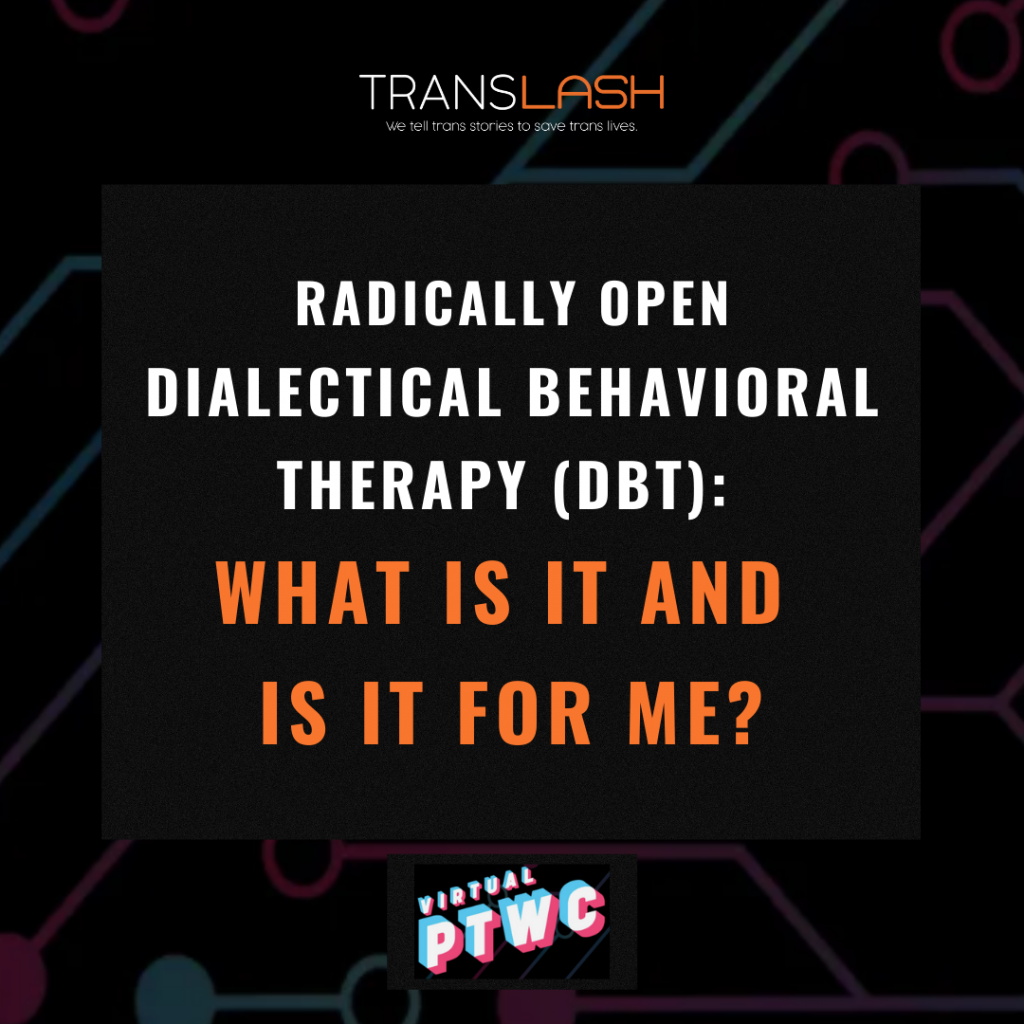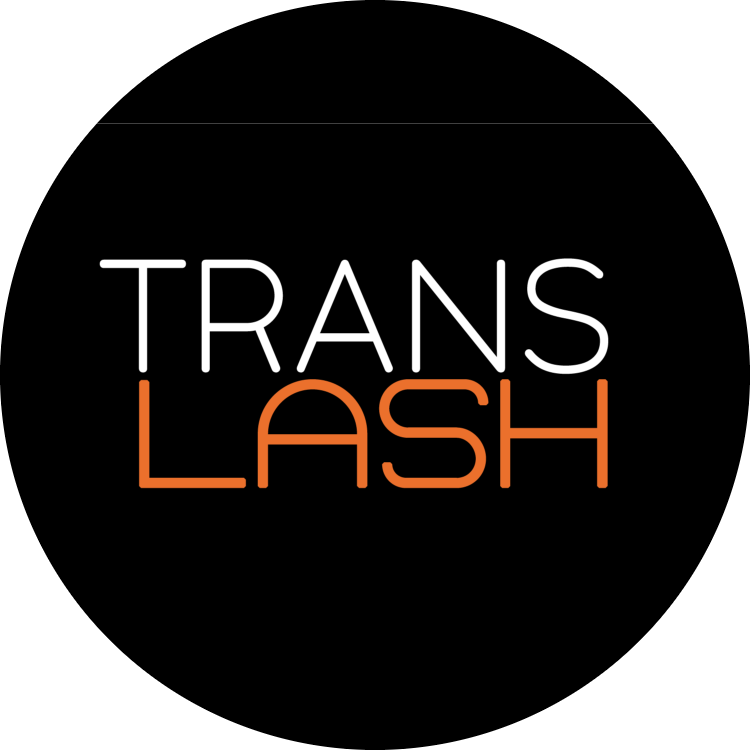
TransLash Media is a proud sponsor of the 2021 Philadelphia Trans Wellness Conference (also referred to as PTWC), which was hosted virtually this year. Though there were chat rooms and mute buttons, the powerful impact of the sessions translated through the screen. People from all walks of life came together to learn how to better be a part of our communities; the conference was nothing short of insightful, engaging, and enlightening.
One of the sessions, Radically Open Dialectical Behavioral Therapy: What Is It and Is It For Me?, introduced us to a relatively new talk therapy: Radically Open Dialectical Behavior Therapy (RO DBT). The speakers on this panel were C. Virginia O’Hayer (She/Her), Clinical Associate Professor at Jefferson City University Hospital, Emily O’Day (She/Her), Practicum Student at Jefferson Center City Clinic for Behavioral Medicine, Francie Fitzgerald (She/Her), Staff Social Worker at Jefferson Center City Clinic for Behavioral Medicine, and Philip Wilson (They/Them), Actor. For the purposes of the panel, Wilson disclosed that they were an RO DBT Patient. Team TransLash condensed the one-hour session into this recap, for your convenience.
What is RO DBT and who does it work for?
Radically Open Dialectical Behavior Therapy (RO DBT) is a new evidence-based treatment, meant to target disorders that carry the component of ‘excessive self control’ (which in this setting, is referred to as overcontrol [OC]), as well as disorders dealing with emotional loneliness. RO DBT was built using 20 years of clinical experience and research by Dr. Thomas R. Lynch, Professor Emeritus in Clinical Psychology at the University of Southampton. His training manual, The RO DBT Textbook and Skills Manual, was published in 2018 (a sample chapter can be read here).
The goal of RO DBT is to support overcontrol (OC) patients in becoming more likely to form stronger social safety systems through increasing behavioral flexibility, openness, and expression of emotion, while working to decrease behavioral over control, aloofness, and emotional loneliness.
TEAM TRANSLASH DISCLAIMER: For folks on the spectrum, RO DBT should not be confused with being forced to participate in masking, which is a complex — and often exhausting — survival strategy for autistic people. It generally involves intentionally learning neurotypical behaviors and mimicking them in social situations. People on the spectrum should not be obligated to mask just so that neurotypical people feel more comfortable. There are benefits to RO DBT for people on the spectrum, and treatment should be adapted to fit each person’s unique lived experience. Set goals with your mental health team that work for you! Here is our resource guide for trans people on the spectrum.
Dialectical Behavioral Therapy (DBT) on its own, focuses itself on identifying negative thinking patterns, and transforming them by encouraging positive behavioral changes. RO DBT is about developing a passion for going in the opposite direction of where you are now. What sets RO DBT apart from DBT, is the added element of the RO: Radical Openness.
Radical Openness is more than the awareness of the issue - it’s also about actively seeking the things you avoid or find uncomfortable in order to learn from them.
It involves purposeful self-enquiry (aka self-inquiry, which involves asking yourself questions in order to discover your personal unknowns, referred to throughout the process as your “edges”), and cultivating a willingness to be “wrong” – with intentions to change for the better if necessary; all in order to learn from a constantly changing world — without feeling like your own is falling apart.
Treatment typically consists of one hour of individual therapy a week, approximately two hours a week of skills training class, consistent therapist consultation team meetings (this is optional but recommended), and telephone consultations as needed. These sessions and consultations are meant to be done in partnership with the The RO DBT Textbook and Skills Manual, and all together lasts a period of 30 weeks.
What does Overcontrol (OC) look like/mean?
Overcontrol is essentially too much of a good thing. When it comes to a person’s self-control tendencies, their psychological well-being should ideally sit happily in a healthy balance of self-care and mindfulness. When their sense of control is higher, they are considered over controlled (OC), which involves high emotional constraint, and risk-aversion.
In a nutshell, the over controlling nature of a person’s mental state can often leave them forgetting their social skills, and communal/group nature.
This can result in a person using mannerisms like wearing a flat face, speaking in a monotone voice, using clipped/short and sharp phrases, having a lack of eye contact, and more, as an attempt to keep their social circle distant from being able to help or be there for them.
People that are over controlled (according to the studies of Dr. Lynch) are more likely to die by suicide and, though risk-averse, are likely to see murder as “a just punishment” (with 44% of the forensic population being cases with over controlled perpetrators).
Overcontrol disorders include (but are not limited to):
- Anorexia Nervosa
- Autism Spectrum Disorders
- Avoidant Personality Disorder
- Chronic Depression
- Internalizing Disorders
- Obsessive Compulsive Personality Disorder
- Paranoid Personality Disorder
- Schizoid Personality Disorder
- Treatment Resistant Anxiety-OCD
When a person’s sense of control is lower, they are considered under controlled (UC), which involves high disinhibition, emotional dysregulation, and impulsivity.
Undercontrol disorders include (but are not limited to):
- Antisocial Personality Disorder
- Binge-Purge Eating Disorders
- Bipolar Disorder
- Borderline Personality Disorder
- Conduct Disorders
- Externalizing Disorders
- Narcissistic Personality Disorder
- Histrionic Personality Disorder
How can RO DBT help LGBTQIA people?
RO DBT places an emphasis on accessing social safety, being openly communicative, creating a chosen family, and using/receiving genuine expression — all of which can be beneficial for LGBTQIA people who experience emotional loneliness, and/or maladaptive over controlled coping. LGBTQIA people often struggle with a lack of full understanding of oneself for many reasons, including personal fear of their unknowns or “edges”, years of suppression/oppression due to abuse, rejection from families, exile from community, etc. The experiences they collect and their unresolved trauma often leave them unsure of where to start. But the start can be radical openness.
We begin building a better relationship with ourselves, and with our chosen families, when we are able to say, “this is not where I want to be, but I will try my best to get there.”
That’s not always an easy thing to do alone, and having a structured plan — with someone holding you accountable for your efforts and progress — can often be helpful. Not only that, but it can allow the space for someone (or a team of people, depending on the situation) to analyze and evaluate you as you go, so you aren’t the only person measuring your progress.
RO DBT also gives you the opportunity to build your understanding of what it takes for you to access a better life within a 30-week span. It usually takes more than a few months to heal fully heal yourself, but going through the experience of RO DBT can reveal for some that it doesn’t have to take a lifetime to experience tangible relief and to develop new coping skills. This is about creating and maintaining your plan of self-care years down the line, and to keep searching within yourself for your unknowns.
RO DBT components and tools make it possible for LGBTQIA people to take their lives back into their own hands, to learn how to fully love and accept all parts of themselves, and to be able to engage in a healthy and happy chosen family.
If you believe RO DBT might be a good option for you, you can read more information about it on the official website, as well as reach out to your healthcare providers for guidance on how to find a practicing therapist near you. RO DBT is a method of therapy often covered by insurance, and is beginning to widen its reach within the world of mental health.
ICYMI: Check out Team TransLash’s trans-affirming mental health resource guide.
Did you find these resources helpful? Consider supporting our work today with a tax-deductible donation.
[Image Description: A black background with faint digital-esque lines of blue and pink, surround a black box with the following text, centered in the image, “TransLash Media: Radically Open Dialectical Behavioral Therapy: What Is It and Is It For Me?, Virtual PTWC]


